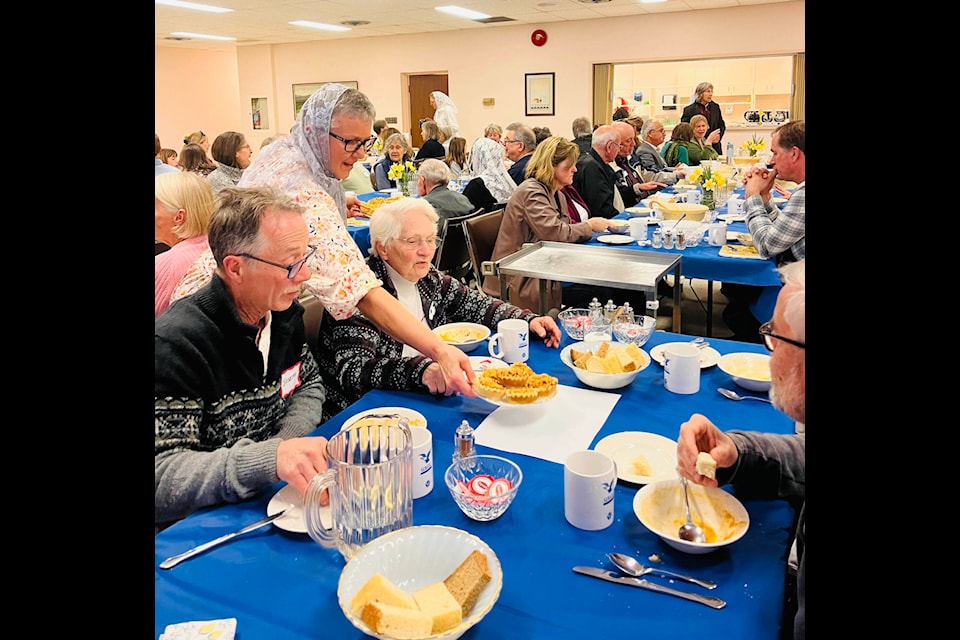A gathering of people came together on Saturday to explore a concept: how does one construct peace?
The 2024 Peace Gathering aimed to answer that question on Saturday at the USCC Hall, with guest speakers, artists and several groups representing different faiths working together to find ways to build new ways to bring about lasting peace.
“The concept of peace is a complex one, yet based on the simple understanding that we all belong to one human family and that harm to one is harm to the whole,” said co-organizer Shelley Grandy. “Peace building requires a humble posture of learning and the respectful atmosphere at each gathering is evidence of this growing awareness.”
That message seemed to resonate with the community as large crowds packed the hall to hear presentations and talk about their perspectives.
Two guest speakers led the talks around how to construct peace. Michael Karlberg is a professor of Communications at Western Washington University and author of books and articles, including Beyond the Culture of Contest. His talk focused on what kind of a world does humanity want to live in and how we are going to have to work collaboratively more if we want to maintain a society.
On a broad scale, he wants to help construct social change through his teaching.
“There’s a lot of focus on ending war, but what I look at is how do we lay the foundations of a more peaceful society and this is something a lot of social movements haven’t given a lot of thought to,” he said. “Competition and conflict have been endemic throughout human history, but western civilization has taken the concept of competition and made it the organizing principle of social life.”
It’s how we structure everything, from political contests, to economic dominance, legal adversarial systems and even educational performance. What he studies is how to move beyond that and create a more co-operative society based on looking for shared interest.
His students are sharing this view more, he said, as they see capitalism as it exists as no longer viable for the long-term future. There are other markets that are going to have to come into play to protect society from sudden booms and crashes that upend social structures.
As a professor, he works with large groups of young people and in recent years, he’s noticed his most recent students are more cynical and despairing than their parents. Part of that reason is that news feeds on their social media are focused on what’s wrong.
They aren’t focusing on constructive subjects or people trying to build new social and economic patterns.
“It’s something you have to learn to look and find and figure out who you want to get involved with,” said Karlberg. “It takes work and it takes recognition that these things are actually happening because the social media algorithms are not driving that into our subconsciousness, so to speak.”
Peacebuilding is an investment many groups have to collaborate on. Like Karlberg, fellow speaker Lorelei Higgins, Rotary Peace Fellow, Mrs. Canada winner and Mediators without Borders consultant spoke on creating a shared path forward. Involved with Rotary since she was 17, Higgins was asked by Rotary to speak at the conference.
She holds a unique position, she said, as the only Indigenous person with Rotary to go to so many peace conferences and through her years in Rotary connected with fellow people who are part of a growing group wanting to do more peace building initiatives.
As a mediator and also a personal mantra, she said her belief is that everyone can build peace everyday. It may seem overwhelming to try to get involved with a broad-reaching issue, such as war or famine, but people can start with their immediate surroundings and personal lives, she said.
“It’s a single person, doing things everyday in a community that helps build peace, like shoveling someone’s walk, taking extra efforts to know your neighbour, learning Indigenous languages of your area. Those are all peace-building activities people don’t realize that,” said Higgins. “Bringing peace to yourself and your family ripples out.”
As a person with Metis heritage, she said her people are seen as a bridge between two cultures. The Peace Gathering is a perfect setting for herself in her culture and training because it’s a cross-sectional setting with different people bringing their backgrounds together.
Along with talks, there was also a community art project led by Rocio Graham where people could make their own peace doves out of pre-cut paper. They could decorate their doves any way they wanted and write their own personalized messages on the doves. The doves will be on display at an exhibit at Gallery 2.
The Doukhobor Choir and a harpist also provided soothing entertainment for the audience.
In previous comments, Graham said as an artist, art can be used to explore difficult subjects in an approachable way and invite people to add their perspective while still being respectful of other people’s views. The dove, a universal symbol of peace, seemed like a perfect project for people.
The Peace Gathering is an outcome of a 2022 directive from the international governing body of the Baha’i Faith calling for a global series of conferences.
Recognising the power of supporting each other’s peace-building activities, the initial collaborators decided to hold another conference in 2023.
The 2023 gathering tripled in the number of participants, increased the number of sponsors, and expanded to include the arts.
This year’s sponsors included Boundary Baha’i Community, Rotary of Grand Forks, USCC Doukhobor Organization, Boundary All Nations Aboriginal Council, artist Rocio Graham and Boundary Peace Initiative. Inspired by these conferences held in Grand Forks, similar ones have taken place this year or are being planned in three other localities, including one in Washington State.
